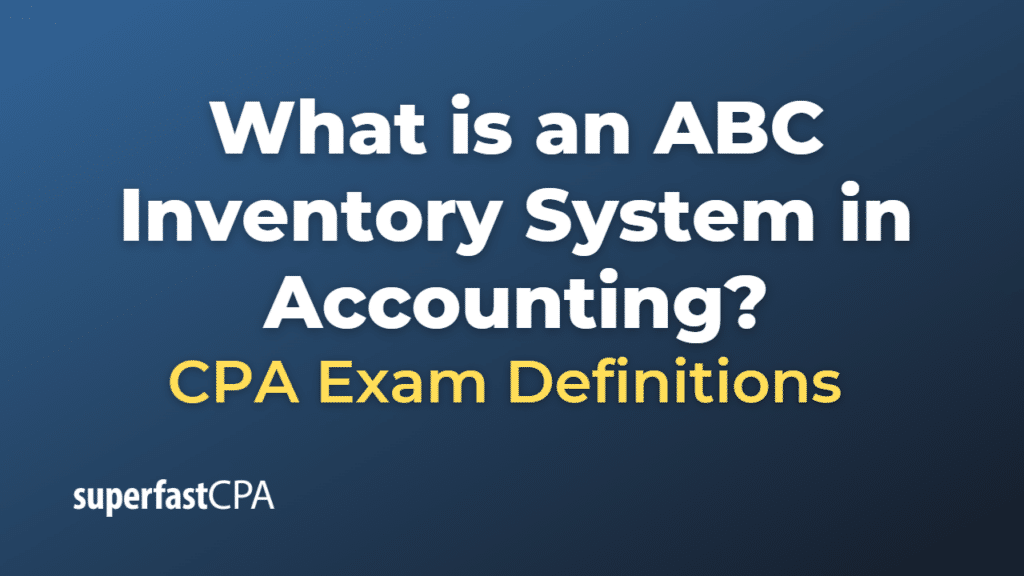ABC Inventory System in Accounting
The ABC inventory system, also known as the ABC analysis or the ABC inventory classification, is a method used in accounting and inventory management to categorize inventory items based on their importance, value, or usage. The system is based on the Pareto Principle, also known as the 80/20 rule, which suggests that a small number of items (approximately 20%) contribute to a significant portion of the total value (approximately 80%).
The ABC inventory system divides inventory items into three categories:
- A-Items: These are high-value items with a significant impact on the overall inventory cost. They typically represent a small percentage of the total inventory items but account for a large portion of the total inventory value. A-items require close monitoring, tight control, and accurate forecasting to minimize stockouts and carrying costs.
- B-Items: These are medium-value items that fall between A-items and C-items in terms of their contribution to the total inventory value. They represent a moderate percentage of total inventory items and inventory value. B-items require a balanced approach to inventory management, with a moderate level of control and monitoring.
- C-Items: These are low-value items with a minimal impact on the overall inventory cost. They usually represent a large percentage of the total inventory items but account for a small portion of the total inventory value. C-items can be managed with less stringent controls, as their carrying costs and stockout costs are relatively low compared to A-items and B-items.
The ABC inventory system helps businesses prioritize their inventory management efforts, focusing on the most valuable items (A-items) to optimize inventory costs, reduce stockouts, and improve overall efficiency. By applying the ABC analysis, organizations can make better decisions regarding inventory control, purchasing, and forecasting, ultimately contributing to better financial performance.
Example of an ABC Inventory System
Let’s consider a hypothetical example of a small retail store that sells electronic gadgets. The store carries a variety of items, such as smartphones, tablets, headphones, chargers, and phone cases. The store owner decides to implement the ABC inventory system to optimize inventory management.
After analyzing the store’s sales data, the owner categorizes the inventory into A, B, and C items based on their value and contribution to the store’s revenue:
- A-Items: High-end smartphones and tablets
- Represent 10% of total inventory items
- Account for 70% of the total inventory value
- B-Items: Mid-range headphones and chargers
- Represent 30% of total inventory items
- Account for 25% of the total inventory value
- C-Items: Phone cases and other low-cost accessories
- Represent 60% of total inventory items
- Account for 5% of the total inventory value
Based on the ABC classification, the store owner can now optimize inventory management:
- A-Items: The owner focuses on maintaining adequate stock levels of high-end smartphones and tablets, as they have the most significant impact on the store’s revenue. They ensure accurate sales forecasting, negotiate better deals with suppliers, and implement tighter inventory control measures to minimize stockouts and carrying costs.
- B-Items: The owner applies a balanced approach to managing mid-range headphones and chargers. They monitor the stock levels and sales trends, adjusting the inventory as needed. However, they do not need to invest as much time and effort as they do with A-items.
- C-Items: The owner applies a more relaxed approach to managing phone cases and other low-cost accessories. They keep sufficient stock levels but do not invest significant resources in controlling these items, as they have a minimal impact on the store’s overall inventory value.
By implementing the ABC inventory system, the store owner can prioritize their inventory management efforts and resources, focusing on the items that contribute the most to the store’s revenue and inventory value. This approach helps the owner optimize inventory costs, improve efficiency, and ultimately increase the store’s profitability.













